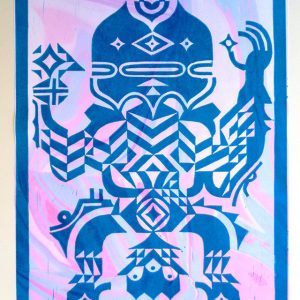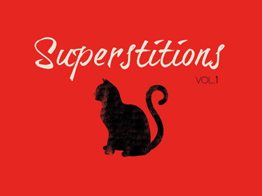Muchas desviaciones de rituales sancionados han persistido durante siglos hasta nuestros días. Han sido fomentados por la ignorancia, el miedo y la esperanza. Algunos son restos calcificados de religiones antiguas y otros son vestigios de propaganda impuesta por una ideología conquistadora. Tal fue el caso de los gatos, otrora sagrados, en el antiguo Egipto, luego despreciados por los cristianos victoriosos y vengativos, que mataban a los gatos mientras ardían las bibliotecas paganas. Debido a su asociación con los herbolarios y como compañeros de las curanderas, fueron diezmados durante las cazas de brujas medievales y en el siglo XVII. Su ausencia dio lugar a las grandes plagas de aquellos tiempos de desinformación. Aún hoy muchos se inquietan al cruzarse un gato en el camino. A pesar de la ciencia y la educación, las supersticiones persisten por fuerza de hábito y tradición.
¿Quién no ha oído hablar de jugadores de béisbol que se ponen los mismos calcetines para cada partido, o de atletas que realizan una secuencia de gestos antes de un evento deportivo porque creen que les traerá suerte? Las supersticiones se manifiestan como una acción, tal como tomar algunos granos de sal derramada y arrojarlos sobre el hombro, o en forma de un objeto, como un tótem, un amuleto, o un talismán. En el fondo, el objetivo de las supersticiones tradicionales es atraer la buena suerte y proteger de la mala suerte. Su omnipresencia global hace de las supersticiones un riquísimo tema de investigación sociológica, antropológica y artística.
Puede que las supersticiones sean parte del ADN de la humanidad y uno de sus legados más duraderos. Dicha propuesta se muestra en las dos series de obras de Arceo Press tituladas “Supersticiones”. Cada artista ha elegido una superstición y el medio gráfico para expresar su punto de vista. Los portafolios reúnen el trabajo de cuarenta y siete artistas y exponen el efecto de las supersticiones sobre los individuos. Cada obra ofrece una vista única sobre este tema inagotable.
Las cuarenta y siete reproducciones se dividen en unas que ilustran las supersticiones culturales y tradicionales, y otras que reinterpretan y critican dichas tradiciones. El primer grupo exhibe las dos tendencias principales que informan una superstición: suscitar y alentar la buena suerte en los ámbitos de la salud, el dinero y el amor, o proteger contra consecuencias negativas para la salud, el dinero y el amor. Estas últimas resultan de la aplicación de la lógica y el pensamiento crítico a unas tradiciones basadas en la fe, el miedo y la esperanza.
Muchos artistas han utilizado esta temática para confrontar críticamente lapsos percibidos en la lógica, la realidad, la verdad y los hechos. Ciertos artistas opinan que, sea por religión o superstición, dichos conceptos se utilizan para manipular y explotar a una población ignorante. Aportan una narración personal y anecdótica a sus exposiciones. Esbozadas desde una perspectiva resentida, las reproducciones afrontan el pasado con humor, tristeza, molestia y aceptación.
Creencias que en su día se consideraban religión convencional se transmutaron a lo largo de los siglos en supersticiones de dudosa aceptación en la sociedad contemporánea pero que aún gozan de amplia aceptación en la cultura popular. Mucha gente no es consciente del origen o la historia de ciertas creencias. Un gesto que aún se realiza es el de “tocar madera,” acto que surgió de la creencia animista pagana de que en los árboles residían espíritus. Tocar madera tendría como efecto despertar el espíritu para proporcionar testimonio y protección contra la maleficencia. En muchas culturas hoy en todo el mundo, se da una palmada o se toca una campana antes de comenzar una oración.
Estamos inmersos en las creencias culturales transmutadas de las religiones más antiguas. Muchas tradiciones han sido absorbidas mientras que su origen se ha perdido en el tiempo. En occidente la cultura greco-romana nos dio el culto de la diosa madre, una deidad de orígenes prehistóricos. Nuestra imaginería cultural se estableció entonces y aún hace referencia a esta afinidad. Muchas de las deidades paganas y semidioses encontraron su contrapartida en los santos cristianos. Una imagen de la diosa romana de la primavera y la fertilidad sosteniendo dos bebés podría fácilmente confundirse con una madona moderna con su niño en brazos.
Entre las muchas creencias metamorfoseadas se encuentra la historia de la Virgen de Guadalupe. Aunque mucha gente en las Américas mantiene una fe profunda en la autenticidad de su aparición, en ámbitos intelectuales su aceptación es dudosa. No por casualidad hizo su aparición en la Colina de Tepeyac, lugar sagrado azteca que albergaba un templo (luego destruido por sacerdotes españoles) dedicado a la diosa madre azteca Tonantzin Coatlaxopeuh. Tonantzin es un título honorífico comparable a “Nuestra Señora” o “Nuestra Gran Madre”. En consecuencia, la frase más famosa en la aparición de Guadalupe, inscrita en la entrada principal de la basílica, reza: “¿No estoy yo aquí, que soy tu madre?” La inquisición de la Iglesia no pudo destruir esa fe que florece del corazón y la mente de Juan Diego. Triunfante, ahora es una creencia incorporada a la iglesia sancionada.
Un ochenta por ciento de la población de los EEUU cree en los ángeles; menos del cuarenta por ciento cree en el cambio climático. No es nada singular en el campo de las creencias de dicho país. Similarmente en el arte tradicional de Asia se encuentran apsaras volantes, mensajeros y espíritus protectores de las nubes y aguas. Aunque vuelan a través del aire no se representan con alas sino con bufandas flotantes, como bailando. La manera occidental de representar ángeles con alas es una invención persa tomada del folclor mesopotámico. Los seres celestiales actuando como mensajeros de los dioses existían ya mucho antes de las religiones abrahámicas. Eran una garantía contra los caprichos del azar.
Si los ángeles han de considerarse como religión o superstición sigue siendo un tema polémico. Gustave Courbet, maestro francés del movimiento realista del siglo XIX, declaró una vez que no podía pintar ángeles porque nunca había visto ninguno. Sin embargo, los ángeles siguen siendo uno de los temas más populares en el arte tradicional, en películas y programas de televisión y libros. Un antecedente moderno de este fenómeno es la obra de William Bouguereau, el más célebre pintor académico en el París del siglo XIX, en un momento en que los impresionistas luchaban por llevar la modernidad y una perspectiva contemporánea al arte. Era el que mejor pintaba ángeles. Su trabajo sigue siendo popular en las tarjetas de Navidad aunque la mayoría de los que las compran no conocen su nombre; aun así, encuentran consuelo en sus imágenes.
Todo ello apunta a que la diferencia entre lo que es religión o superstición permanece en el corazón y en la mente del creyente. Estas series de reproducciones pueden aportar consuelo a través del reconocimiento, provocando un recuerdo, pueden suscitar una discusión o provocar una risa, pero innegablemente se trata de un tema humano que además forma parte de la discusión sobre la condición humana.
Jose Andreu, 2017
Translation: Ignacio Durán
igiduran@gmail.com


























